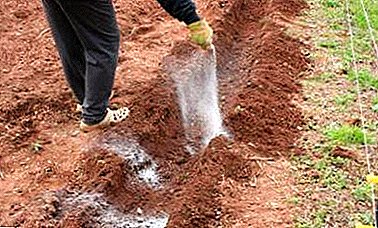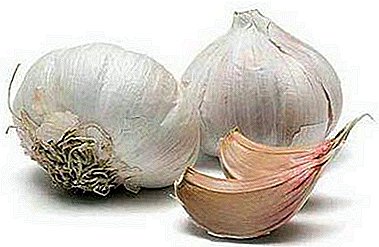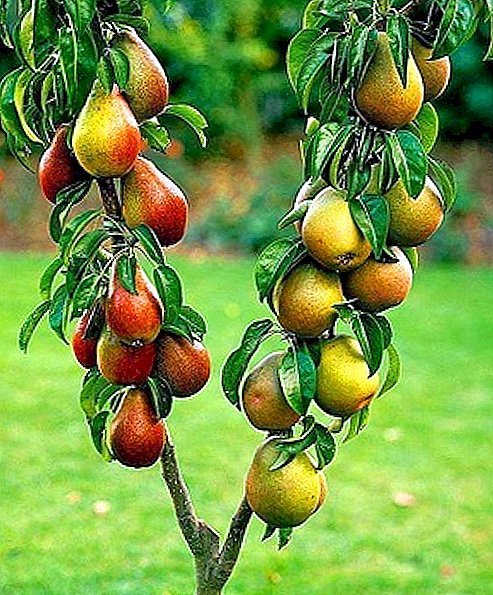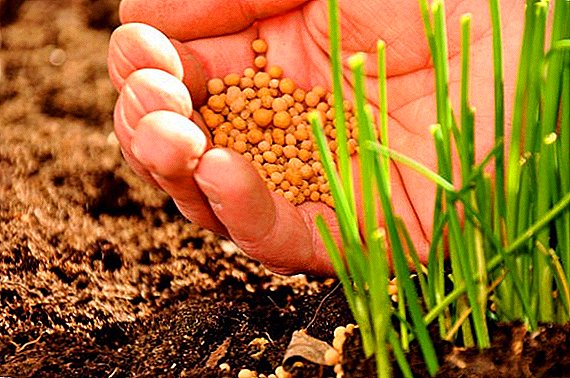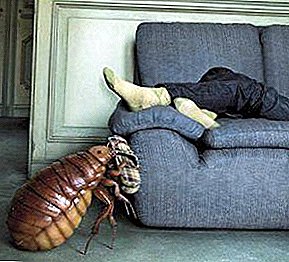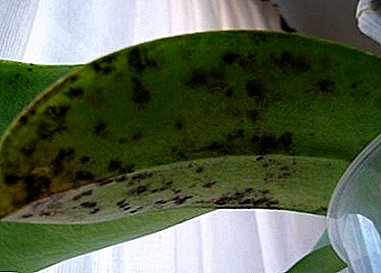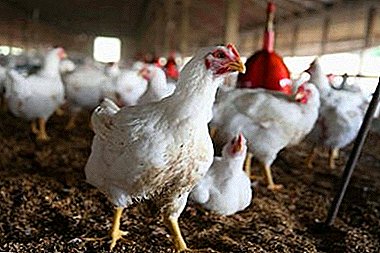
Many people who do not understand how to breed poultry, believe that broilers are no different from ordinary chickens, and special care is not required. However, this is not the case. 2-3 months is necessary for a broiler chicken to become an adult, and early age is considered the most vulnerable. There are many reasons why chickens can get sick. Which ones? Consider them in more detail.
Possible reasons
Broiler chicken is an early hybrid of domestic chickens, which was obtained by interbreeding. The main causes of the appearance of disease in birds are:
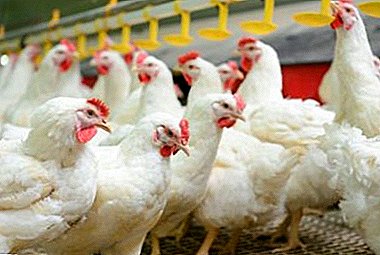 avitaminosis: most often D, A, B;
avitaminosis: most often D, A, B;- lack of calcium in the body;
- stay in a room with low temperature, high humidity and lack of sunlight;
- creation of excessively sterile conditions in the habitat;
- overpopulation of chickens;
- the emergence of infectious diseases.
Frequent ailments - symptoms, treatment
There is a risk group of chicks, which are characterized by a certain age of broilers and require special care and attention. These include:
- 0-5 days;
- 20-25 days;
- 35-40 days.
Sit on their feet
The main reasons for the fall of broilers to their feet are:
- overweight;
- poor diet with a lack or lack of vitamins and trace elements;
- violation of the technology of the bird's stay - a cold, damp room with a lack of light;
- overcrowding broilers.
To eliminate falling on the feet of chicks it is necessary to balance their food. It is required to give the chickens green fodder from chopped leaves and stalks of plants, for example, nettle. From 5 days of life of chickens, you can enter products containing vitamin A and E: beets, germinated grain, carrots, cabbage.
 Do not forget about vitamins. The drug Solyushn should be given during the first 3 days of life of broilers, followed by replacement with calcium with vitamin D. Do not forget about regular exposure to sunlight: this is the natural production of vitamin D. To prevent hypervitaminosis, chicks should follow a strict diet.
Do not forget about vitamins. The drug Solyushn should be given during the first 3 days of life of broilers, followed by replacement with calcium with vitamin D. Do not forget about regular exposure to sunlight: this is the natural production of vitamin D. To prevent hypervitaminosis, chicks should follow a strict diet.
For the proper formation of bones and the functioning of the nervous and immune systems, the ingestion of chickens of sufficient calcium content is necessary. This is done by introducing into the diet of natural sources of the microelement - the shell of eggs, ordinary chalk.
Under unsuitable conditions of chickens (overcrowding, cold, humid room with a lack of light and no litter) all unfavorable stay conditions are required.
Sneeze
Due to the fact that the birds are overcooled, there is a greater likelihood of colds. They begin to sneeze, their breathing becomes difficult, and mucus is released from the beak.
Important! At the first manifestations of the disease, it is required to immediately transplant sick birds separately from others in order to avoid an epidemic.
The room is treated with a disinfectant., and broilers begin treatment: independently with a mild course, and by a veterinarian, in the case of a protracted or severe form of infection.
Cough up
The common cause of coughing in birds is a cold. They begin to breathe through their mouths, hoarseness and difficulty in breathing occur, chickens carry eggs less and cannot eat and eat on their own. If wheezing well starts to be bugged in the trachea, mucous discharge appears when coughing, the inflammatory process has affected the bronchi.
Wheezing
The appearance of wheezing or even whistling in birds indicates such ailments:
- infectious lesion of the bronchi;
- bronchopneumonia;
- escherichiosis.
Additional symptoms are the immobility of chickens, the rejection of food and water intake. Most often, wheezing is formed with a greatly weakened immunity.
Diarrhea
There are several reasons why broilers begin to disturb liquid stools. These include the following ailments:
 Hypothermia: watery manure with undigested food particles.
Hypothermia: watery manure with undigested food particles.- Poultry transportation.
- Replacing feed.
- Drinking poor quality.
- Feeding disorders: overfeeding with plant foods, diets high in protein and potassium, excess lipids and fiber, as well as poor-quality feed.
- Pathological processes in the intestines: its population by opportunistic microbes: clostridia, Escherichia coli, coccidia.
- Viral infection.
- Poisoning: toxic substances can be in the feed or feed additives.
Runny nose
Due to improper keeping of chickens, respiratory diseases can occur, in particular, the appearance of rhinitis. The disease most often occurs in the autumn-winter period. If the infection is caused by a virus, other birds in the same room with a sick broiler will be in danger. For this reason it is necessary to isolate it.
How to find out if a bird suffers from a cold? The disease is characterized by the following symptoms:
- The appearance of mucous discharge from the nose.
- Broiler breathing through the mouth.
- Sneezing
- The presence of a dirty beak with dried crusts in the area of the nostrils.
For treatment use vitamins that give a drink with water. Some people use tetracycline with chloramphenicol: 1 tablet per 1000 ml of water.
Lower extremity injury
The main illnesses, diseases of the feet, are:
- Arthritis and tendovaginitis: with inflammation of the joints and tendons, limping of chickens appears, an increase in the joint on the lower limb with a surface that is hot to the touch. Vet examination is required, who will prescribe anti-inflammatory drugs.
- Knemidokoptoz - chicken scabies: the causative agent of the disease - a scabby mite transmitted by contact to other individuals. If the poultry farmers ignore the symptoms, the disease can last for years. Signs of illness: the formation of ugly growths on the legs, the appearance of scales with a white patina, prone to flaking and falling away, and anxiety chickens.
 Curly and crooked fingers: The causes of the appearance of pathology are many. For the prevention of disease requires the creation of optimal conditions for the maintenance of broilers and the provision of feed with the necessary nutrients.
Curly and crooked fingers: The causes of the appearance of pathology are many. For the prevention of disease requires the creation of optimal conditions for the maintenance of broilers and the provision of feed with the necessary nutrients.- Chicken limp: most often occurs due to mechanical damage to the lower limbs or excessive weight of the broiler. The chicken is lame, its legs are trembling, it tries not to stand for a long time. Bird foot inspection required. If there is a cut, treat with hydrogen peroxide or iodine solution.
- Tendon displacement - perosis: occurs because of a lack of vitamin B group. In a far advanced process, the bird is unable to eat and drink on its own, and the joints of the lower limbs swell and turn outwards.
Blindness
The appearance of blindness in 1 eye indicates the development of the infectious process of the bird. The most common causes are salmonellosis and vitamin deficiency. Signs of salmonellosis:
- loss of feathers;
- refusal of poultry to feed and drink;
- weakness;
- the appearance of shortness of breath.
In adults there are additional manifestations of the disease:
- Reduced egg production.
- Blanching scallop.
- The appearance of ruffled plumage.
- The appearance of lameness.
- Blindness for 1 eye.
Attention! The disease is contagious to the surrounding birds, so most often the sick chicken is sent for slaughter.
Another cause of blindness is avitaminosis. With a lack of vitamin A, inflammation of the mucous membrane of the eye appears, which leads to the development of the disease.
Additional symptoms:
- the formation of cheesy discharge from the eyes;
- desiccation of the corneal sheath;
- attempts by the bird to scratch the claw of the eye;
- redness of the eyelid skin.
It is necessary to recognize the symptoms in time to prevent the blindness of the chicken. For treatment, you need to adjust the food with the addition of products containing vitamin A.
Viral ailments
There are several of the most common diseases in chickens, due to which not only the sick individual, but also the whole brood can suffer.
Dyspepsia
With poor feeding, chickens often have an illness. Indigestion is more susceptible to birds that have reached the age of 3 weeks, with an early introduction to the diet of coarse, low-nutritional or difficult to digest food. Dyspepsia can be triggered by drinking dirty, stagnant water.
Symptoms:
 decreased appetite;
decreased appetite;- bowel overflow with gas, causing the stomach to feel hard;
- the appearance of liquid litter containing undigested food particles;
- chicken weakness.
In acute form, there is an increased body temperature. In severe cases, convulsions and exhaustion occur.
Treatment:
Introducing a broiler diet that is easily digestible. Products must not cause rotting or fermentation. As a drink, hens are given weak solutions of soda or potassium permanganate. If we are talking about toxic poisoning, antibacterial drugs are used.
Bronchopneumonia
Illness is called the inflammatory process in the bronchioles with the appearance of edema in them.
Causes of illness:
- Infectious lesion of the upper respiratory tract.
- Complicated course of bronchitis.
- Permanent adverse environmental factors when combined with internal (reduced body defenses, lack of vitamins).
The disease is manifested by a lack of appetite in broiler, weakness. Observed rapid and heavy breathing with the appearance of moist rales.
Important! If the bird was not treated promptly, it dies within a few days.
At an early stage, Spisentol is sprayed indoors with chicken, which is pre-diluted in the same ratio with water. With the development of the process, the bird is isolated and treated with antibiotics (Tetramycin, Penicillin).
Hypovitaminosis
 With a lack of vitamins B, PP, C, A and E can be observed manifestations of the disease. If hypovitaminosis appeared at the stage of embryo development, it can provoke a disturbance in the formation of nervous, cartilage and connective tissues. With a shortage of substances there is a lag of the bird in growth and body weight, a decrease in immunity.
With a lack of vitamins B, PP, C, A and E can be observed manifestations of the disease. If hypovitaminosis appeared at the stage of embryo development, it can provoke a disturbance in the formation of nervous, cartilage and connective tissues. With a shortage of substances there is a lag of the bird in growth and body weight, a decrease in immunity.
For the treatment of the disease requires the use of vitamin supplements. With the severe development of hypovitaminosis, an injected vitamin is given.
Newcastle
This is a dangerous viral disease of broilers. It affects the nervous, respiratory system and internal organs. Other names of the disease - pseudo-pusum, pneumoencephalitis, Asian plague. Its source is sick or recovered chicken. Carriers of infection - birds, humans, domestic animals, insects and rodents. Newcastle disease is characterized by an aerogenic route of infection.
Symptoms:
- Weakness and lethargy.
- Difficulty breathing with discharge of mucus from the beak.
- The appearance of loose stools.
In the case of the nervous form of the disease is noted:
- poor coordination of chickens;
- neck bending and twisting;
- the development of the half-wings of the wings, legs, tail.
Respiratory form is characterized by:
- Respiratory failure with difficulty breathing and wheezing.
- The development of suffocation, causing the bird to perish.
Treatment:
Therapy is not carried out due to danger and inexpediency. Patients are destroyed by suffocation, and healthy vaccines are delivered. On the economy must impose a quarantine.
Useful video about Newcastle disease
Mycoplasmosis
 This disease is caused by mycoplasma and affects the respiratory tract of broilers.
This disease is caused by mycoplasma and affects the respiratory tract of broilers.
The main pathogen varieties are Mycoplasma gallisepticum and Mycoplasma synoviae.
Transmitted by contact, aerogenic and transovarial route.
Imperceptible onset of the disease, lasting up to 3 weeks.
Symptoms in chicks:
- The appearance of impaired breathing with shortness of breath, moist rales and frothy secretions of the respiratory tract.
- Loss of appetite.
- Lagging birds in development.
In adults:
- The defeat of the reproductive system, manifested by a decrease in egg production and the death of embryos.
- The appearance of respiratory syndrome: shortness of breath, moist rales, frothy discharge from the respiratory tract.
- The defeat of the organ of vision in the form of conjunctivitis.
Treatment:
Antibiotics are used - pneumotyl, tilazin. Also in the hen house air is sanitized with solutions of Ecocide, lactic acid. Do not forget about fortified feed.
Marek's disease
Caused by a virus that affects the nervous system and organ of vision of broilers.
Symptoms:
- Change the bird's pupil and iris. In a neglected case, complete blindness occurs.
- Impaired coordination of movement and the appearance of lameness.
- Occurrence of goiter paralysis, leading to exhaustion.
- Blanching of the mucous membranes.
Aspergillosis
The disease does not respond to therapy. When an accurate diagnosis is established, the sick bird must be destroyed. Aspergillosis is a fungal infection that affects the respiratory tract of the young.
Symptoms:
- the appearance of weakness and lethargy chicken;
- refusal of food;
- the occurrence of wheezing.
Treatment
Conduct antibiotic therapy, which are appointed exclusively by the veterinarian!
Prevention
To grow healthy broilers, you must follow certain rules:
- Nutrition with the necessary content of vitamins and minerals.
- Feed drink from nipple drinkers.
- Providing optimal conditions for indoor birds.
- The content in the coop individuals of the same species and age.
- Regular exposure to the sun.
- Timely detection of diseased chickens with isolation from healthy individuals.
Conclusion
Diseases of broilers can lead to the death of not only the sick bird, but also the surrounding animals. For this reason, it is necessary to create favorable conditions for their maintenance. When the first symptoms of the disease appear, it is necessary to start treatment and, if necessary, use the services of a veterinarian.


 avitaminosis: most often D, A, B;
avitaminosis: most often D, A, B; Hypothermia: watery manure with undigested food particles.
Hypothermia: watery manure with undigested food particles. Curly and crooked fingers: The causes of the appearance of pathology are many. For the prevention of disease requires the creation of optimal conditions for the maintenance of broilers and the provision of feed with the necessary nutrients.
Curly and crooked fingers: The causes of the appearance of pathology are many. For the prevention of disease requires the creation of optimal conditions for the maintenance of broilers and the provision of feed with the necessary nutrients. decreased appetite;
decreased appetite;
